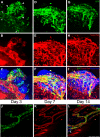Donor islet endothelial cells in pancreatic islet revascularization
- PMID: 21873551
- PMCID: PMC3178280
- DOI: 10.2337/db10-1711
Donor islet endothelial cells in pancreatic islet revascularization
Abstract
Objective: Freshly isolated pancreatic islets contain, in contrast to cultured islets, intraislet endothelial cells (ECs), which can contribute to the formation of functional blood vessels after transplantation. We have characterized how donor islet endothelial cells (DIECs) may contribute to the revascularization rate, vascular density, and endocrine graft function after transplantation of freshly isolated and cultured islets.
Research design and methods: Freshly isolated and cultured islets were transplanted under the kidney capsule and into the anterior chamber of the eye. Intravital laser scanning microscopy was used to monitor the revascularization process and DIECs in intact grafts. The grafts' metabolic function was examined by reversal of diabetes, and the ultrastructural morphology by transmission electron microscopy.
Results: DIECs significantly contributed to the vasculature of fresh islet grafts, assessed up to 5 months after transplantation, but were hardly detected in cultured islet grafts. Early participation of DIECs in the revascularization process correlated with a higher revascularization rate of freshly isolated islets compared with cultured islets. However, after complete revascularization, the vascular density was similar in the two groups, and host ECs gained morphological features resembling the endogenous islet vasculature. Surprisingly, grafts originating from cultured islets reversed diabetes more rapidly than those originating from fresh islets.
Conclusions: In summary, DIECs contributed to the revascularization of fresh, but not cultured, islets by participating in early processes of vessel formation and persisting in the vasculature over long periods of time. However, the DIECs did not increase the vascular density or improve the endocrine function of the grafts.
Figures




References
-
- Shapiro AM, Ricordi C, Hering BJ, et al. International trial of the Edmonton protocol for islet transplantation. N Engl J Med 2006;355:1318–1330 - PubMed
-
- Mattsson G, Jansson L, Carlsson PO. Decreased vascular density in mouse pancreatic islets after transplantation. Diabetes 2002;51:1362–1366 - PubMed
-
- Davalli AM, Scaglia L, Zangen DH, Hollister J, Bonner-Weir S, Weir GC. Vulnerability of islets in the immediate posttransplantation period. Dynamic changes in structure and function. Diabetes 1996;45:1161–1167 - PubMed
-
- Lai Y, Schneider D, Kidszun A, et al. Vascular endothelial growth factor increases functional beta-cell mass by improvement of angiogenesis of isolated human and murine pancreatic islets. Transplantation 2005;79:1530–1536 - PubMed
Publication types
MeSH terms
Substances
Grants and funding
LinkOut - more resources
Full Text Sources
Other Literature Sources
Medical

